Search
- Page Path
-
- HOME
- Search
- Review Article
- Cardiology
- Environmental changes surrounding congenital heart disease
- Eun-Young Choi
- Clin Exp Pediatr. 2023;66(8):332-338. Published online January 2, 2023
-
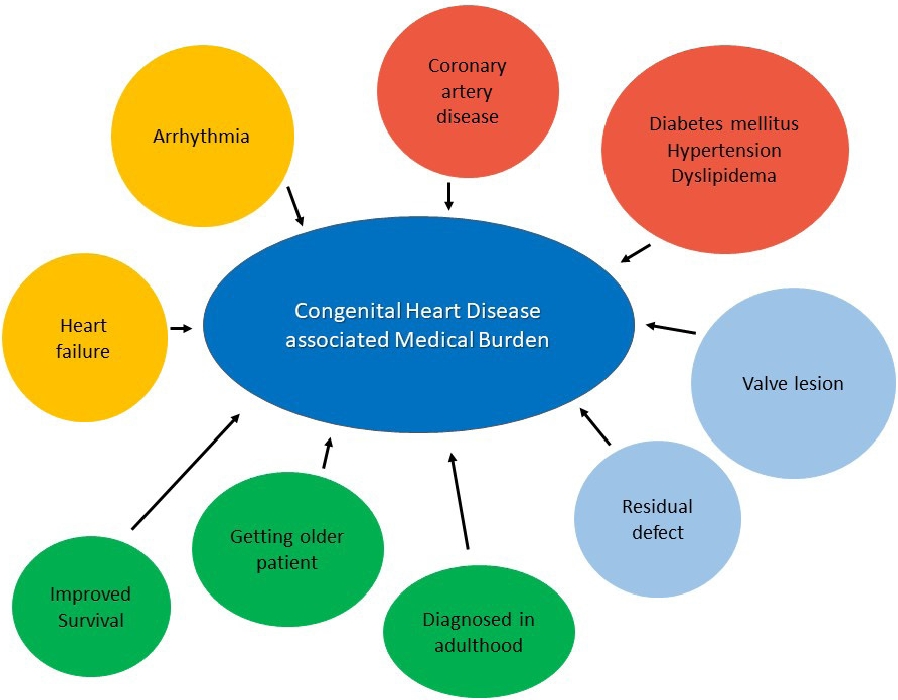
· As the number of patients with congenital heart disease increases, the medical burden increases.
· Various fusion imaging techniques using percutaneous procedures have been introduced.
· With advances in technology, convenient ambulatory devices have been introduced.
· A well-organized team approach is required to resolve advanced heart failure in patients with congenital heart disease.
- Neonatology (Perinatology)
- Treatment of congenital cytomegalovirus infection
- Gyu Hong Shim
- Clin Exp Pediatr. 2023;66(9):384-394. Published online December 28, 2022
-
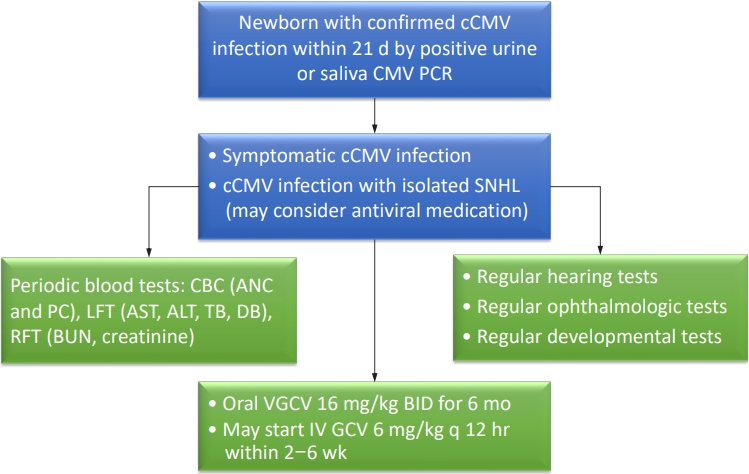
· Congenital cytomegalovirus (CMV) infection is among the most common causes of nongenetic sensorineural hearing loss.
· Congenital CMV is initially treated with intravenous ganciclovir for 2–6 weeks and switched to oral valganciclovir, or with oral valganciclovir for the entire 6-month period.
· Infants with congenital CMV require periodic monitoring of absolute neutrophil count, platelet count, and blood urea nitrogen, creatinine, liver function tests, audiological, ophthalmological, and developmental tests during antiviral medication.
- Original Article
- Neurology
- Neurodevelopmental outcomes and comorbidities of children with congenital muscular torticollis: evaluation using the National Health Screening Program for Infants and Children database
- Og Hyang Kim, Seung Won Lee, Eun Kyo Ha, Ju Hee Kim, Yun Hye Jo, Seongyeong Rhie, Man Yong Han, Kyu Young Chae
- Clin Exp Pediatr. 2022;65(6):312-319. Published online December 9, 2021
-

Question: What comorbidities are increased in children with congenital muscular torticollis (CMT)? Are there differences in the neurodevelopmental outcomes of children with CMT who received physical therapy versus those who did not?
Finding: The risk of congenital musculoskeletal deformities is increased in CMT. Children who did not receive physical therapy were at greater risk of neurodevelopmental delay.
Meaning: In CMT, musculoskeletal comorbidities should be identified and active early treatment provided.
- Review Article
- Cardiology
- Application of CRISPR-Cas9 gene editing for congenital heart disease
- Heeyoung Seok, Rui Deng, Douglas B. Cowan, Da-Zhi Wang
- Clin Exp Pediatr. 2021;64(6):269-279. Published online March 2, 2021
-
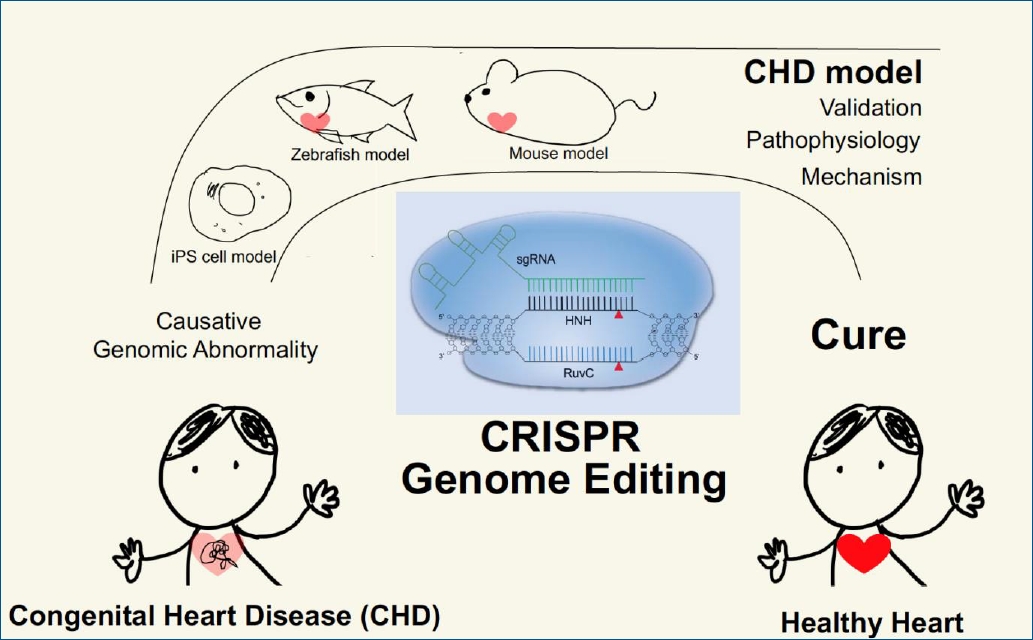
Clustered regularly interspaced short palindromic repeats and CRISPR-associated protein 9 (CRISPR-Cas9) system has made a big step in the genome editing which still requires technical developments for the efficient applications in the many fields including congenital heart diseases (CHDs), closely related to the genomic abnormality. In this review, we tried to cover the most updated researches of CRISPR-Cas9 in the CHDs to understand the current technologies, eventually becoming therapeutic bases for the CHD patients.
- Original Article
- Neonatology (Perinatology)
- New modified version of the Risk Adjustment for Congenital Heart Surgery category and mortality in premature infants with critical congenital heart disease
- Young Mi Yoon, Seong Phil Bae, Yoon-Joo Kim, Jae Gun Kwak, Woong-Han Kim, Mi Kyoung Song, Seung Han Shin, Ee-Kyung Kim, Han-Suk Kim
- Clin Exp Pediatr. 2020;63(10):395-401. Published online July 15, 2020
-
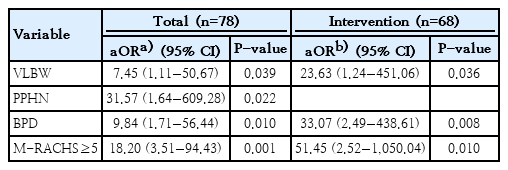
Questions: This study aimed to describe the survival of premature infants with critical congenital heart disease (CHD) and to identify the risk factors including the new modified version of the Risk Adjustment for Congenital Heart Surgery (M-RACHS) associated with mortality.
Finding: For premature infants with critical CHD, survival rate was 76.9% and very low birth weight (VLBW), persistent pulmonary hypertension of the newborn (PPHN), bronchopulmonary dysplasia (BPD), and M-RACHS 5 or more were associated with in-hospital mortality.
Meaning: VLBW, PPHN and BPD, as well as M-RACHS≥5, were risk factors for mortality among premature infants with critical CHD.
- Review Article
- Nephrology (Genitourinary)
- Reconsideration of urine culture for the diagnosis of acute pyelonephritis in children: a new challenging method for diagnosing acute pyelonephritis
- Jun Ho Lee, Seonkyeong Rhie
- Clin Exp Pediatr. 2019;62(12):433-437. Published online October 18, 2019
-

Acute pyelonephritis (APN) should be detected and treated as soon as possible to reduce the risk of the development of acquired renal scarring. However, in the medical field, urine culture results are not available or considered when the prompt discrimination of APN is necessary and empirical treatment is started. Furthermore, urine culture cannot discriminate APN among children with febrile urinary...
- Original Article
- Neonatology (Perinatology)
- Dorsal midline cutaneous stigmata associated with occult spinal dysraphism in pediatric patients
- Hyun Jung Sung, Hyun-Seung Lee
- Clin Exp Pediatr. 2019;62(2):68-74. Published online October 1, 2018
-

Purpose: To investigate the prevalence of occult spinal dysraphism (OSD) and subsequent neurosurgery in pediatric patients with isolated or combined dorsal midline cutaneous stigmata with or without other congenital malformations. Methods: We carried out a retrospective review of patients who underwent sonography or magnetic resonance imaging (MRI) for OSD because of suspicion of dorsal midline cutaneous stigmata (presumed to be a...
- Cardiology
- Outcomes of transcatheter closure of ductus arteriosus in infants less than 6 months of age: a single-center experience
- Gwang-Jun Choi, Jinyoung Song, Yi-Seul Kim, Heirim Lee, June Huh, I-Seok Kang
- Clin Exp Pediatr. 2018;61(12):397-402. Published online September 19, 2018
-

Purpose: Transcatheter device closure of patent ductus arteriosus (PDA) is challenging in early infancy. We evaluated PDA closure in infants less than 6 months old. Methods: We performed a retrospective review of infants less than 6 months of age who underwent attempted transcatheter device closure in our institution since 2004. To compare clinical outcomes between age groups, infants aged 6–12 months...
- Endocrinology
- Final height of Korean patients with early treated congenital hypothyroidism
- Jiyun Lee, Jeongho Lee, Dong Hwan Lee
- Clin Exp Pediatr. 2018;61(7):221-225. Published online July 15, 2018
-
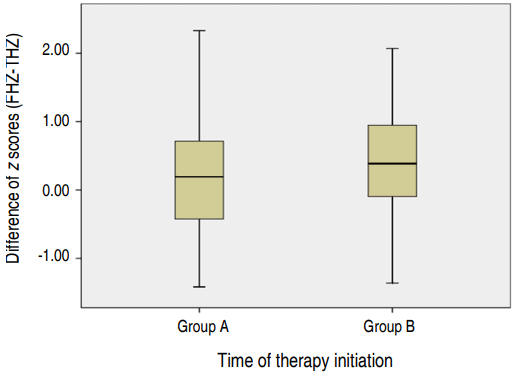
Purpose: Congenital hypothyroidism (CH) is the most common endocrine disorder in children. Thyroid hormone deprivation results not only in mental retardation but also growth retardation. This study investigates the final height (FH) in Korean patients with CH detected by newborn screening and examines factors that may affect the FH. Methods: The medical records of Korean CH patients (n=45) were reviewed. The...
- Cardiology
- The outcome of percutaneous stent implantation in congenital heart disease: experience of a single institute
- Moon Sun Kim, Ja Kyoung Yoon, Seong Ho Kim, Ji Seok Bang, So Ick Jang, Sang Yoon Lee, Eun Young Choi, Su Jin Park, Hye Won Kwon
- Clin Exp Pediatr. 2018;61(6):187-193. Published online June 25, 2018
-

Purpose The efficacy of percutaneous stent implantation for congenital heart disease (CHD) in Korea, where stent availability is limited, has not been determined. This study evaluated the acute and midterm results of stent implantation in different CHD subgroups.
Methods Stents were implanted in 75 patients with 81 lesions: (1) pulmonary artery stenosis (PAS) group, 56 lesions in 51 patients; (2) coarctation of the...
- Case Report
- Neonatology (Perinatology)
- Case of mucinous adenocarcinoma of the lung associated with congenital pulmonary airway malformation in a neonate
- Juneyoug Koh, Euiseok Jung, Se Jin Jang, Dong Kwan Kim, Byong Sop Lee, Ki-Soo Kim, Ellen Ai-Rhan Kim
- Clin Exp Pediatr. 2018;61(1):30-34. Published online January 22, 2018
-
Congenital pulmonary airway malformation (CPAM), previously known as congenital cystic adenomatoid malformation, is a rare developmental lung abnormality associated with rhabdomyosarcoma, pleuropulmonary blastoma, and mucinous adenocarcinoma of the lung. We report an unusual case of a 10-day-old male newborn with a left lower lobe pulmonary cyst who underwent lobectomy, which revealed type II CPAM complicated by multifocal mucinous adenocarcinoma. KRAS...
- Review Article
- Cardiology
- Recent advances in pediatric interventional cardiology
- Seong-Ho Kim
- Clin Exp Pediatr. 2017;60(8):237-244. Published online August 14, 2017
-
During the last 10 years, there have been major technological achievements in pediatric interventional cardiology. In addition, there have been several advances in cardiac imaging, especially in 3-dimensional imaging of echocardiography, computed tomography, magnetic resonance imaging, and cineangiography. Therefore, more types of congenital heart diseases can be treated in the cardiac catheter laboratory today than ever before. Furthermore, lesions previously...
- Endocrinology
- Management issues of congenital adrenal hyperplasia during the transition from pediatric to adult care
- Jin-Ho Choi, Han-Wook Yoo
- Clin Exp Pediatr. 2017;60(2):31-37. Published online February 27, 2017
-
Steroid 21-hydroxylase deficiency is the most prevalent form of congenital adrenal hyperplasia (CAH), accounting for approximately 95% of cases. With the advent of newborn screening and hormone replacement therapy, most children with CAH survive into adulthood. Adolescents and adults with CAH experience a number of complications, including short stature, obesity, infertility, tumor, osteoporosis, and reduced quality of life. Transition from...
- Case Report
- Neurology
- Megalencephaly-capillary malformation-polymicrogyria syndrome: the first case report in Korea
- Yeon-Chul Choi, Mi-Sun Yum, Min-Jee Kim, Yun-Jung Lee, Tae-Sung Ko
- Clin Exp Pediatr. 2016;59(Suppl 1):S152-S156. Published online November 30, 2016
-
Megalencephaly-capillary malformation-polymicrogyria syndrome (MCAP), previously known as macrocephaly-cutis marmorata telangiectatica congenita and macrocephaly-capillary malformation syndrome, is a rare multiple-malformation syndrome that is characterized by progressive megalencephaly, capillary malformations of the midline face and body, or distal limb anomalies such as syndactyly. Herein, we report a female infant case that satisfies the recently proposed criteria of MCAP and describe the distinctive...
- Endocrinology
- A novel mutation of
ABCC8 gene in a patient with diazoxide-unresponsive congenital hyperinsulinism - Ji Sook Park, Hong-Jun Lee, Chan-Hoo Park
- Clin Exp Pediatr. 2016;59(Suppl 1):S116-S120. Published online November 30, 2016
-
Congenital hyperinsulinism (CHI) is a rare condition that can cause irreversible brain damage during the neonatal period owing to the associated hypoglycemia. Hypoglycemia in CHI occurs secondary to the dysregulation of insulin secretion. CHI has been established as a genetic disorder of islet-cell hyperplasia, associated with a mutation of the
ABCC8 orKCNJ11 genes, which encode the sulfonylurea receptor 1...
- Pulmonology
- Congenital miliary tuberculosis in an 18-day-old boy
- Jue Seong Lee, Chang Hoon Lim, Eunji Kim, Hyunwook Lim, Yoon Lee, Ji Tae Choung, Young Yoo
- Clin Exp Pediatr. 2016;59(Suppl 1):S64-S67. Published online November 30, 2016
-
Congenital tuberculosis (TB) is a rare disease that is associated with high mortality.
Mycobacterium tuberculosis , the causative agent, may be transmitted from the infected mother to the fetus by the transplacental route or by aspiration of infected amniotic fluid. Clinical symptoms and signs are not specific. Miliary patterns are the most common findings in the chest X-rays of many infants...
- Genetics and Metabolism
- A nonsense
PAX6 mutation in a family with congenital aniridia - Kyoung Hee Han, Hye Jin Lee, Il-Soo Ha, Hee Gyung Kang, Hae Il Cheong
- Clin Exp Pediatr. 2016;59(Suppl 1):S1-S4. Published online November 30, 2016
-
Congenital aniridia is a rare ocular malformation that presents with severe hypoplasia of the iris and various ocular manifestations. Most cases of congenital aniridia are known to be related to mutations in the paired box gene-6 (
PAX6 ), which is an essential gene in eye development. Herein, we report a familial case of autosomal dominant congenital aniridia with four affected members...
- Original Article
- Cardiology
- Impact of postoperative duration of Aspirin use on longevity of bioprosthetic pulmonary valve in patients who underwent congenital heart disease repair
- Tae-Woong Hwang, Sung-Ook Kim, Sang-Yun Lee, Seong-Ho Kim, Eun-Young Choi, So-Ick Jang, Su-Jin Park, Hye-Won Kwon, Hyo-Bin Lim, Chang-Ha Lee, Eun-Seok Choi
- Clin Exp Pediatr. 2016;59(11):446-450. Published online November 18, 2016
-
Purpose Generally, aspirin is used as a protective agent against thrombogenic phenomenon after pulmonary valve replacement (PVR) using a bioprosthetic valve. However, the appropriate duration of aspirin use is unclear. We analyzed the impact of postoperative duration of aspirin use on the longevity of bioprosthetic pulmonary valves in patients who underwent repair for congenital heart diseases.
Methods We retrospectively reviewed the clinical data...
- Review Article
- Kabuki syndrome: clinical and molecular characteristics
- Chong-Kun Cheon, Jung Min Ko
- Clin Exp Pediatr. 2015;58(9):317-324. Published online September 21, 2015
-
Kabuki syndrome (KS) is a rare syndrome characterized by multiple congenital anomalies and mental retardation. Other characteristics include a peculiar facial gestalt, short stature, skeletal and visceral abnormalities, cardiac anomalies, and immunological defects. Whole exome sequencing has uncovered the genetic basis of KS. Prior to 2013, there was no molecular genetic information about KS in Korean patients. More recently, direct...
- Original Article
- The strong association of left-side heart anomalies with Kabuki syndrome
- Ja Kyoung Yoon, Kyung Jin Ahn, Bo Sang Kwon, Gi Beom Kim, Eun Jung Bae, Chung Il Noh, Jung Min Ko
- Clin Exp Pediatr. 2015;58(7):256-262. Published online July 22, 2015
-
Purpose Kabuki syndrome is a multiple congenital malformation syndrome, with characteristic facial features, mental retardation, and skeletal and congenital heart anomalies. However, the cardiac anomalies are not well described in the Korean population. We analyzed the cardiac anomalies and clinical features of Kabuki syndrome in a single tertiary center.
Methods A retrospective analysis was conducted for a total of 13 patients with Kabuki...
- Thyroid dysfunction in very low birth weight preterm infants
- Ji Hoon Lee, Sung Woo Kim, Ga Won Jeon, Jong Beom Sin
- Clin Exp Pediatr. 2015;58(6):224-229. Published online June 22, 2015
-
Purpose Thyroid dysfunction is common in preterm infants. Congenital hypothyroidism causes neurodevelopmental impairment, which is preventable if properly treated. This study was conducted to describe the characteristics of thyroid dysfunction in very low birth weight infants (VLBWIs), evaluate risk factors of hypothyroidism, and suggest the reassessment of thyroid function with an initially normal thyroid-stimulating hormone (TSH) as part of a newborn...
- Review Article
- Current insights into inherited bone marrow failure syndromes
- Nack-Gyun Chung, Myungshin Kim
- Clin Exp Pediatr. 2014;57(8):337-344. Published online August 25, 2014
-
Inherited bone marrow failure syndrome (IBMFS) encompasses a heterogeneous and complex group of genetic disorders characterized by physical malformations, insufficient blood cell production, and increased risk of malignancies. They often have substantial phenotype overlap, and therefore, genotyping is often a critical means of establishing a diagnosis. Current advances in the field of IBMFSs have identified multiple genes associated with IBMFSs...
- Case Report
- Congenital muscular dystrophy type 1A with residual merosin expression
- Hyo Jeong Kim, Young-Chul Choi, Hyung Jun Park, Young-Mock Lee, Heung Dong Kim, Joon Soo Lee, Hoon-Chul Kang
- Clin Exp Pediatr. 2014;57(3):149-152. Published online March 31, 2014
-
Congenital muscular dystrophy type 1A (MDC1A) is an autosomal recessive disorder characterized by hypotonia, elevated serum creatine kinase level, delayed motor milestones, white matter changes observed by brain magnetic resonance imaging, and normal intelligence. A mutation in the laminin α2 (
LAMA2 ) gene, located at 6q22-23, is a genetic cause of MDC1A. Patients have merosin (laminin α2)-deficient skeletal muscles. However, the...
- Original Article
- Characteristics of thyroid nodules in infant with congenital hypothyroidism
- Seo Young Youn, Jeong Ho Lee, Yun-Woo Chang, Dong Hwan Lee
- Clin Exp Pediatr. 2014;57(2):85-90. Published online February 24, 2014
-
Purpose This study aimed to assess the characteristics of thyroid nodules among infants diagnosed with congenital hypothyroidism.
Methods A retrospective study of 660 infants (374 males, 286 females) diagnosed with congenital hypothyroidism was carried out at the Pediatric Endocrine Clinic in Soonchunhyang University Hospital, Korea, between May 2003 and February 2013. The average age at diagnosis was 1.16±1.68 months.
Results Of the 28 patients (4.2%)...
- Implantable cardioverter defibrillator therapy in pediatric and congenital heart disease patients: a single tertiary center experience in Korea
- Bo Kyung Jin, Ji Seok Bang, Eun Young Choi, Gi Beom Kim, Bo Sang Kwon, Eun Jung Bae, Chung Il Noh, Jung Yun Choi, Woong Han Kim
- Clin Exp Pediatr. 2013;56(3):125-129. Published online March 18, 2013
-
Purpose The use of implantable cardioverter defibrillators (ICDs) to prevent sudden cardiac death is increasing in children and adolescents. This study investigated the use of ICDs in children with congenital heart disease.
Methods This retrospective study was conducted on the clinical characteristics and effectiveness of ICD implantation at the department of pediatrics of a single tertiary center between 2007 and 2011.
Results Fifteen patients underwent...
- Review Article
- Right ventricular failure in congenital heart disease
- Young Kuk Cho, Jae Sook Ma
- Clin Exp Pediatr. 2013;56(3):101-106. Published online March 18, 2013
-
Despite developments in surgical techniques and other interventions, right ventricular (RV) failure remains an important clinical problem in several congenital heart diseases (CHD). RV function is one of the most important predictors of mortality and morbidity in patients with CHD. RV failure is a progressive disorder that begins with myocardial injury or stress, neurohormonal activation, cytokine activation, altered gene expression,...
- Original Article
- Recent incidence of congenital heart disease in neonatal care unit of secondary medical center: a single center study
- Seon Young Cho, Jin-Hee Oh, Jung Hyun Lee, Jae Young Lee, Soon Ju Lee, Ji Whan Han, Dae Kyun Koh, Chang Kyu Oh
- Clin Exp Pediatr. 2012;55(7):232-237. Published online July 17, 2012
-
Purpose With feasibility in the diagnoses of congenital heart disease (CHD) in the antenatal period, we suspect changes have occurred in its incidence. No data have been reported about the current incidence of simple forms of CHD in Korea. We have attempted to assess the recent incidence and characteristics of CHD in the neonatal care unit of a secondary referral medical...
- Case Report
- Early congenital syphilis presenting with skin eruption alone: a case report
- Hak Young Kim, Beom Joon Kim, Ji Hyun Kim, Byoung Hoon Yoo
- Clin Exp Pediatr. 2011;54(12):512-514. Published online December 31, 2011
-
Congenital syphilis is one of the most well-known congenital infections, yet it remains a worldwide public health problem. Congenital syphilis can involve any organ system and present with various symptoms. However, early diagnosis of congenital syphilis is difficult because more than half of the affected infants are asymptomatic, and the signs in symptomatic infants may be subtle and nonspecific. Here,...
- Review Article
- Respiratory syncytial virus prevention in children with congenital heart disease: who and how?
- Nam Kyun Kim, Jae Young Choi
- Clin Exp Pediatr. 2011;54(5):197-200. Published online May 31, 2011
-
Respiratory syncytial virus (RSV) is a major cause of respiratory infection in children. Most of the pediatric population have RSV infection before the age of 2, and recurrent infections are common even within one season. Chronic lung disease, prematurity, along with congenital heart disease (CHD) are major risk factors in severe lower respiratory infection. In hemo-dynamically significant CHD patients with...
- Respiratory syncytial virus infection in children with congenital heart disease: global data and interim results of Korean RSV-CHD survey
- Jo Won Jung
- Clin Exp Pediatr. 2011;54(5):192-196. Published online May 31, 2011
-
Respiratory syncytial virus (RSV) is a main cause of hospitalization for bronchiolitis and pneumonia in infants worldwide. Children with hemodynamically significant congenital heart disease (HS-CHD), as well as premature infants are at high risk for severe RSV diseases. Mortality rates for CHD patients hospitalized with RSV have been reported as about 24 times higher compared with those without RSV infection....
-

-
-
Impact Factor3.2
-
8.02023CiteScore94th percentilePowered by
-









